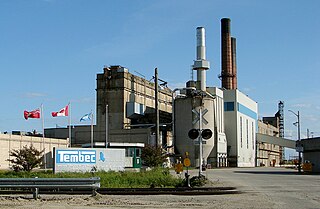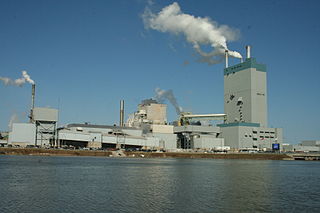The pulp and paper industry in Canada is one of the country's most important and profitable industries.[ citation needed ]. It is especially concentrated in Ontario and Quebec and plays an important role in many other provinces.[ citation needed ].
The leading forest and paper products companies in Canada in net sales in 2012 were: [1]
| Rank | Company | 2012 Net Sales (US$M) | 2012 Net Income (Loss) (US$M) |
|---|---|---|---|
| 1 | Domtar Inc. | 5,482 | 172 |
| 2 | Resolute Forest Products | 4,503 | (2) |
| 3 | Cascades Inc. | 3,646 | (11) |
| 4 | West Fraser Timber | 3,001 | 87 |
| 5 | Canfor | 2,715 | 32 |
| 6 | Tembec | 1,667 | (82) |
| 7 | Norbord | 1,149 | 72 |
| 8 | Mercer International | 1,073 | (16) |
| 9 | Catalyst | 1,059 | 583 |
| 10 | Millar Western Forest Products Ltd. | 926 | 29 |
In 2000, Canadian pulp, paper and paperboard companies had operating expenses of C$425.4 million on environmental protection with the majority ($263.3 million) used for pollution abatement. Capital expenditures totalled $234.8 million, with over half ($140.4 million) being spent on pollution prevention processes.

Pulp is a fibrous lignocellulosic material prepared by chemically, semi-chemically or mechanically producing cellulosic fibers from wood, fiber crops, waste paper, or rags. Mixed with water and other chemicals or plant-based additives, pulp is the major raw material used in papermaking and the industrial production of other paper products.

The pulp and paper industry comprises companies that use wood, specifically pulpwood, as raw material and produce pulp, paper, paperboard, and other cellulose-based products.

Georgia-Pacific LLC is an American pulp and paper company based in Atlanta, Georgia, and is one of the world's largest manufacturers and distributors of tissue, pulp, paper, toilet and paper towel dispensers, packaging, building products and related chemicals, and other forest products -- largely made from its own timber. Since 2005, it has been an independently operated and managed subsidiary of Koch Industries. As of Fall 2019, the company employed more than 35,000 people at more than 180 locations in North America, South America and Europe.
The United States is one of the biggest paper consumers in the world. Between 1990 and 2002, paper consumption in the United States increased from 84.9 million tons to 97.3 million tons. In 2006, there were approximately 450 paper mills in the United States, accounting for $68 billion.
The pulp and paper industry in Europe accounts for about a quarter of world production and is a major employer. The leading producing countries are Finland, Sweden and Germany. The industry is a large user of renewable energy and achieved a recycling rate of 71.5% in 2015.

Paperboard is a thick paper-based material. While there is no rigid differentiation between paper and paperboard, paperboard is generally thicker than paper and has certain superior attributes such as foldability and rigidity. According to ISO standards, paperboard is a paper with a grammage above 250 g/m2, but there are exceptions. Paperboard can be single- or multi-ply.

Tembec Industries Inc., known as Tembec, was a paper company in Canada, founded by Frank Dottori. In 2011, Tembec had approximately 3000 employees, with locations in Canada, United States, and France. Tembec's operating divisions included Forest Products, Pulp, Paper & Paperboard, and Chemicals.

Communications, Energy and Paperworkers Union of Canada, abbreviated CEP in English and SCEP in French, was a largely private-sector labour union with 150,000 members, active from 1992 to 2013. It was created in 1992 through the merger of three unions: the Canadian Paperworkers Union, the Communications and Electrical Workers of Canada, and the Energy and Chemical Workers Union. See below for some other unions that were merged into the CEP. CEP/SCEP was affiliated to the Canadian Labour Congress.

The recycling of paper is the process by which waste paper is turned into new paper products. It has a number of important benefits: It saves waste paper from occupying homes of people and producing methane as it breaks down. Because paper fibre contains carbon, recycling keeps the carbon locked up for longer and out of the atmosphere. Around two-thirds of all paper products in the US are now recovered and recycled, although it does not all become new paper. After repeated processing the fibres become too short for the production of new paper, which is why virgin fibre is frequently added to the pulp recipe.
Asubpeeschoseewagong First Nation is an Ojibwe First Nations band government who inhabit northern Kenora in Ontario, Canada. Their landbase is the 4,145 ha English River 21 Indian Reserve. It has a registered population of 1,595 as of October 2019, of which the on-reserve population was 971. As of October 2023, the community had a registered population of 1,608. They are a signatory to Treaty 3.

Resolute Forest Products, formerly known as AbitibiBowater Inc., is a Canada-based pulp and paper company. Headquartered in Montreal, Quebec, the company was formed in 2007 by the merger of Bowater and Abitibi-Consolidated. At that time, the merged company was the third largest pulp and paper company in North America, and the eighth largest in the world.

A forest product is any material derived from forestry for direct consumption or commercial use, such as lumber, paper, or fodder for livestock. Wood, by far the dominant product of forests, is used for many purposes, such as wood fuel or the finished structural materials used for the construction of buildings, or as a raw material, in the form of wood pulp, that is used in the production of paper. All other non-wood products derived from forest resources, comprising a broad variety of other forest products, are collectively described as non-timber forest products (NTFP). Non-timber forest products are viewed to have fewer negative effects on forest ecosystem when providing income sources for local community.
Tree-free paper, also known as no tree paper, offers an alternative to traditional wood-pulp paper due to its unique raw material composition. This type of paper is considered more eco-friendly especially when evaluating its entire life cycle.
The Forest Products Association of Canada (FPAC) is a trade association which represents Canada's wood, pulp and paper producers both nationally and internationally in government, trade, and environmental affairs. Canada's forest products industry is an $80 billion a year industry that represents 2% of Canada's GDP.

The Great Lakes Paper Company was the operator of the largest and most modern pulp and paper manufacturing facility in the world. The Company employed over 4,000 in Northern Ontario, starting in 1924 as a pulp mill at Fort William, Ontario. Great Lakes had a highly developed social network within the company, including a children's Christmas party held at a local arena, and an annual picnic held at a local park, as well as many sports teams and other social groups. The company's working environment was enhanced by cultural diversity. For example under the Government of Canada's immigration policy, the "Close Relatives Scheme" resulted in over 400 Ukrainian refugees being employed as workers after World War II.

The environmental impact of paper are significant, which has led to changes in industry and behaviour at both business and personal levels. With the use of modern technology such as the printing press and the highly mechanized harvesting of wood, disposable paper became a relatively cheap commodity, which led to a high level of consumption and waste. The rise in global environmental issues such as air and water pollution, climate change, overflowing landfills and clearcutting have all lead to increased government regulations. There is now a trend towards sustainability in the pulp and paper industry as it moves to reduce clear cutting, water use, greenhouse gas emissions, fossil fuel consumption and clean up its influence on local water supplies and air pollution.

The Dryden pulp mill, also known as the Reed Mill, is a paper and pulp mill in Dryden, Ontario. During the 1960s and 70s, mercury poisoning from the mill caused one of Canada's worst environmental disasters: Dryden Chemicals Ltd dumped mercury into the English-Wabigoon River, upstream of Grassy Narrows First Nation, poisoning the fish which were their staple food. Members of the Grassy Narrows and the Whitedog communities downstream from the mill suffered severe mercury poisoning.
Royale is a Canadian brand of consumer household paper products such as facial tissue, bathroom tissue, paper towels, and paper napkins. The brand is owned by Canadian paper company Irving Tissue.
The wood industry or timber industry is the industry concerned with forestry, logging, timber trade, and the production of primary forest products and wood products and secondary products like wood pulp for the pulp and paper industry. Some of the largest producers are also among the biggest owners of forest. The wood industry has historically been and continues to be an important sector in many economies.

Mercury contamination in Grassy Narrows was an uncontrolled discharge of between 9,000 kilograms (20,000 lb) and 11,000 kilograms (24,000 lb) of mercury from the Dryden Mill's chloralkali plant in Dryden into the headwaters of the Wabigoon River in the Kenora District of Northwestern Ontario from 1962 until 1970. It was described as "one of the worst cases of environmental poisoning in Canadian history." The contamination poisoned many people in the Grassy Narrows First Nation and Whitedog First Nation communities.
{{cite journal}}: Cite journal requires |journal= (help)